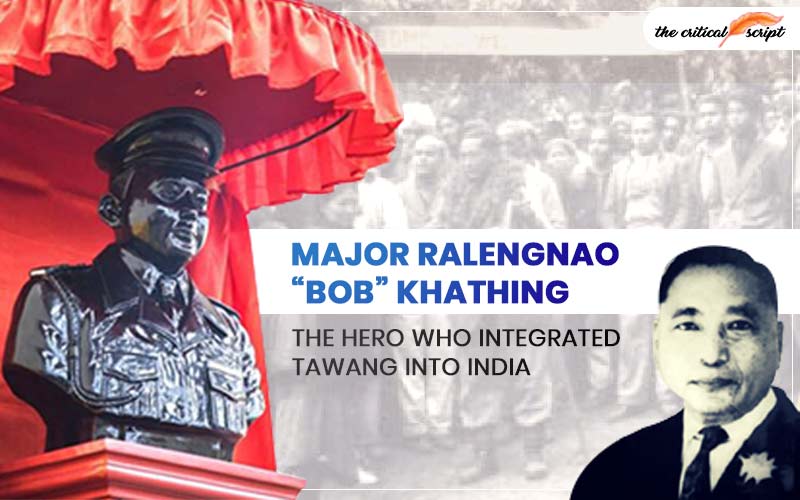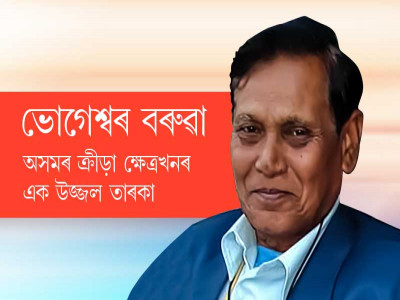
Major Ralengnao “Bob” Khathing: The Hero Who Integrated Tawang into India
Major Ralengnao “Bob” Khathing is
a name revered in India’s northeastern history, particularly in Arunachal
Pradesh. Known for his daring mission to peacefully integrate the Tawang region
into India in 1951, Major Khathing was more than just a military officer—he was
a diplomat, visionary, and a hero whose contributions helped shape the future
of India’s northeastern frontier. His life is a testament to courage,
resilience, and the role of northeast India in the nation’s story.
Born in 1912 in Ukhrul, a town in
Manipur, Ralengnao Bob Khathing hailed from the Tangkhul Naga tribe, a
community known for its strong values and deep connection to the land.
Khathing’s early education at Ukhrul, Cotton College in Assam, and later St.
Paul’s Cathedral Mission College in Kolkata was groundbreaking, as very few
from his community had access to formal education during that era. His
educational journey equipped him with a deep sense of purpose and the skills to
serve his community and his country.
Khathing joined the British
Indian Army, where he quickly distinguished himself as a soldier and leader.
During World War II, he served with the British Indian Army in the Burma
Campaign, a grueling series of battles against the Japanese forces in Southeast
Asia. His exceptional bravery and tactical expertise during the campaign earned
him several accolades, and he was soon widely respected by his peers and
superiors alike. It was this reputation that paved the way for his most
defining mission—securing India’s northeastern frontier.
The Tawang region in what is now
Arunachal Pradesh was under Tibetan influence, and the local Monpa
population had a long-standing cultural and religious connection with Tibet.
After India’s independence in 1947, establishing administrative control over
the remote and culturally distinct northeast regions became critical. With
China’s growing influence in Tibet, Prime Minister Jawaharlal Nehru’s
government recognized the importance of securing Tawang for India. To achieve
this, India needed a bold yet diplomatic leader who could integrate Tawang
without military confrontation. Major Khathing, with his nuanced understanding
of northeastern culture and his formidable leadership skills, was chosen for
the mission.
In January 1951, Major Khathing,
along with a small contingent of Assam Rifles and officials, set off on a
daunting journey to Tawang. The terrain was challenging, and the political
situation was sensitive. His mission was to raise the Indian flag in Tawang,
establish a civil administration, and peacefully assert India’s authority in
the region. Khathing’s approach was one of respect and diplomacy. He took time
to understand the customs and sentiments of the local Monpa population and
engaged with community leaders, explaining India’s intent without force.
On February 6, 1951, Major
Khathing achieved a historic milestone—he hoisted the Indian flag in Tawang,
symbolizing the region’s integration into India. He set up administrative
infrastructure and established relationships with local leaders, ensuring that
Tawang’s integration was not just political but also peaceful and culturally
sensitive. This diplomatic mission was a masterstroke, and it marked a
significant achievement in India’s territorial integrity.
Major Khathing’s mission in
Tawang was one of peaceful diplomacy, earning him deep respect and admiration
in the region. His success not only secured India’s northeastern borders but
also laid a foundation of trust between the people of Arunachal Pradesh and the
Indian government. Khathing’s accomplishment was crucial, particularly given
the geopolitical tensions with China, which have persisted to this day.
For decades, Major Khathing
remained an unsung hero outside the Northeast, even though his contributions
were acknowledged within Northeastern communities. His work was not celebrated
widely in Indian history books, and it wasn’t until recent years that his
legacy started receiving the recognition it deserved. In 2021, the Indian
government announced the creation of a memorial and museum in Tawang dedicated
to Major Khathing, finally giving him the honor and remembrance befitting a
national hero.
Major Khathing’s life was a blend
of valor and humility. He wasn’t just a soldier—he was a diplomat, a visionary,
and a man deeply committed to the cause of his country. His legacy is
particularly meaningful to the people of Arunachal Pradesh and the larger
northeastern region, as he symbolizes a bridge between the people of the Northeast
and the rest of India. Khathing’s achievements show the importance of cultural
sensitivity in governance, especially in a diverse country like India, where
unity is woven from respect for regional identities.
Today, Major Khathing’s story
serves as an inspiration for all Indians, particularly those from the
northeastern states. He reminds us of the courage required not just on the
battlefield but in uniting people with compassion and respect. His life and
legacy highlight the vital role played by the Northeast in shaping India’s
destiny and securing its frontiers.
By preserving his memory, India
honors the bravery, diplomacy, and vision of Major Khathing and acknowledges
the immense contributions of northeastern communities in nation-building. His story
remains a proud chapter in the history of Arunachal Pradesh, and his legacy is
a beacon for those who continue to protect and preserve India’s borders and its
unity.
To honour his legacy this Diwali
the Government of India is inaugurating the Major Ralengnao Bob Khathing Museum
of Valour in Tawang.
Disclaimer: The opinions expressed in this article are those of the author's. They do not purport to reflect the opinions or views of The Critical Script or its editor.

Newsletter!!!
Subscribe to our weekly Newsletter and stay tuned.

















Related Comments